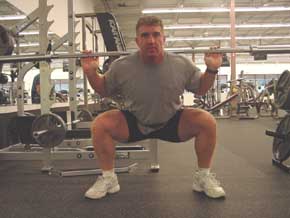Squat workout: Build leg strength with squats
Mike Furci home / Fitness Channel / Bullz-Eye Home
Some say the squat is the king of all leg exercises. They even go as far as saying that if you don’t squat, your chances of building big, strong legs are next to impossible. And there are others who even take it one step further, claiming the squat is the best overall exercise there is period, and no routine should be without one.
Yes, I agree that the squat is unquestionably a very productive exercise in that it works a large number of major muscle groups. More so than any other exercise, however, it is not essential to do the barbell squat in order to get muscular and strong legs.
I do believe the squat is a very effective mass and strength builder, but for some the pain it causes due to injuries or anatomy makes this exercise very uncomfortable. Others who have trouble doing squats are those who have very long legs and short torsos. These individuals have a very hard time being successful with this movement due to poor biomechanics. Some people need alternatives. But, for this article I am going to focus on how to perform the barbell squat properly and show how to change what muscles are emphasized.
The Barbell Squat
• Start with your body directly in the center of the bar. Place your feet approximately shoulder width apart directly under the bar. Maintain the lordotic curve in your lower back with your chest up. Your head is pointed straight ahead or slightly upward. Do not look down. The body follows the head.
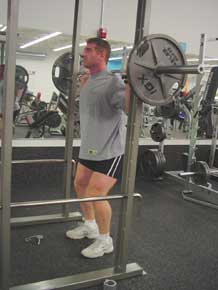
• Once you are in position, take two to three small steps back.
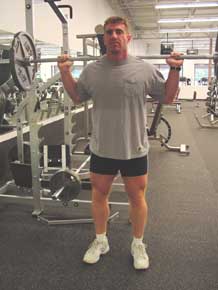
• Take a deep breath, flex your knees and hips as you lower your body. As you come down, your hips should move backward like you were going to sit down in a chair. Your torso should start to move forward maintaining the lordotic curve with you chest and head up.
The picture below shows an example of what not to do while performing a squat. Never allow your knees to move medially (inside your feet). This is often a sign of weak
glutes.
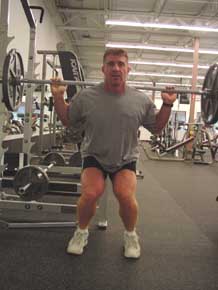
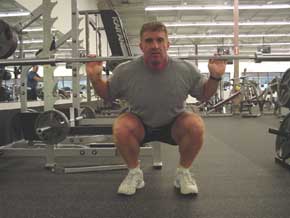
Notice above that my head is up, my body is centered underneath the bar, and my knees are over my feet.
• The picture below shows the proper form at the bottom of the movement. Notice the position of my head and hips. Never allow your heels to come off the floor. Both feet should be in full contact with the floor at all times. If your heels do come up your knees are too far forward. To remedy this throw your hips farther back.
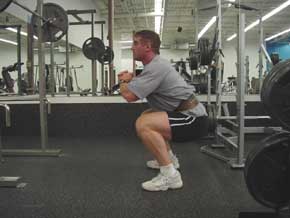
• After you reach the bottom position, start to reverse direction by pushing through your heels. As you begin your assent, start to exhale. Return to the start position.
Muscles involved: Hamstrings, quadriceps, glutes, and the erector muscles of the
back. The erector muscles contract isometricly to keep the normal curvature of the spine.
You can change the degree of stress placed upon certain muscle groups by changing the width of your stance. In the first picture below you see a shoulder width stance. This is more difficult than a wider stance and places an emphasis on the quadriceps. In the second picture a wider stance targets the abductor muscles (outer thigh) and allows you to use more weight, but lessens the stress on the quads.

